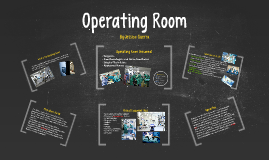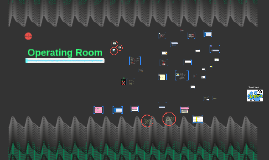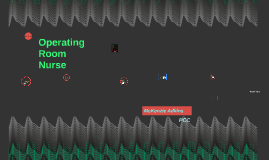Operating Room
Transcript: Surgery by Caroline Hernandez The Surgical Unit Most people think of a Surgical Unit, a.k.a the operating room (OR), as quite scary but out of all honesty its the unit that needs to provide impeccable care to their patients. In this unit it's a matter of life or death and what goes on in that room is extremely crucial. The OR is where all types of surgery happen, no matter how minor. It's a place full of stress! An OR is a room in a hospital specially equipped for surgical operations. The Health Care Providers behind it all. . . The health care providers that you usually find in the operating room are surgeons, whom could be specialized in something specific like neuro surgery; as well as OR Nurses. OR Nurses are nurses completely specified to work in the operating rooms and while on duty can have one of two main jobs, either be a "scrubs" or a "circulation"; these are simply names that describe the specific job they are performing. For example, a "scrubs" will be working with the surgeon around the sterilized area, while a "circulation" will not go near the sterilized area and only observe and help from afar. Other health care providers usually are an anesthesiologist and a surgical technician- this is the person who prepares the room before surgery. The Education Needed You will not be able to get out of going to school if you wish to work in the OR. OR Nursing- A Bachelor’s of Science in Nursing (BSN), a registered nurse license, at least 1 year's experience in a nursing setting, a graduates degree for OR nurse assistance or nurse anesthesia, and lastly you must pass a national certification exam. Surgeon- a Bachelor's degree in science, four years of medical school to become an M.D., and 3-8 years of surgical residency at a hospital as well as certification to practice legally. Anesthesiologist- a Bachelor's degree in science, medical school to become an M.D. and then 4 years of residency. Surgical Technician- an Associate's degree in appropriate field and certifications such as a CST (Certified Surgical Technologist). Medical Conditions found Reasons for needing surgery can vary and trust me there's a huge variety. The medical conditions can range from getting your tonsils taken out, because your constantly getting infections, to needing brain surgery. The most common reason for brain surgery is Oedema, which is basically swelling of the brain and surgery is needed to change or move some brain tissue. Cancer patients are also seen in the OR because they may need to remove a cancerous tumor or they may have to have a bone marrow transplant. The Environment Brightly lit, cold and stressful would be your typical day in the operating room. Everything is completely sterilized and disinfected. You wouldn't even be caught dead without a mask, gloves, scrubs on top of scrubs, and shoe covers. Trust me they do everything physically possible to prevent the spread of germs in the OR. It's usually fast past with patient right after patient and very tough. The staff undergoes quite a bit of pressure trying to remain calm for the patients sake but also having to get the job done smoothly and correct. Example of PPE: Equipment The type of equipment you would normally see in the surgery unit are things like an operating bed and patient monitors; as well as diagnostic tools, respiratory and cardiac support. You would also see tools such as various types of surgical scaples, surgical staples and sutures, which are usually laid out on a cart near the surgeon. Emergency Equipment Something Special The surgery department is the only true place that perform complete surgeries. An interesting surgery that is performed, is a CABG, which stands for Coronary Artery Bypass Grafting. A CABG surgery is done in order to create new routes, around any and all arteries that may be blocked or are too narrow, for sufficient blood flow through the heart. The surgery is interesting because it basically requires the surgeon to stop the heart. What the surgeon has to do during this operation is he has to open up the chest and cut the sternum in half in order to get to the heart. Then he must stop the heart and use a heart lung machine to keep the blood flow going. The surgeon then forms the graft (which is usually taken from the legs) to where it can bypass the blockage, basically rerouting the blood flow. CABG Image •Crash cart— include medications and defibrillators, is to stabilize a respiratory or cardiac emergency •Hyperthermia cart—To treat a potential fatal reaction to anesthesia •Tracheostomy tray—To maintain an emergency airway •Jet ventilator—To assist with adult respiratory distress syndrome •Suction apparatus—To remove fluid such as blood or respiratory secretions •IV (intravenous) set-ups—To administer blood or IV fluids such as saline or lactated ringers. The Dictionary Definition:

















